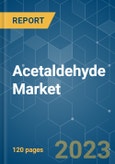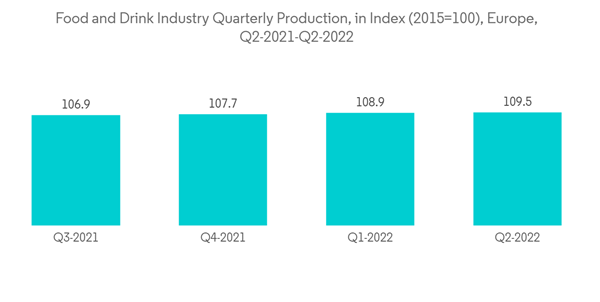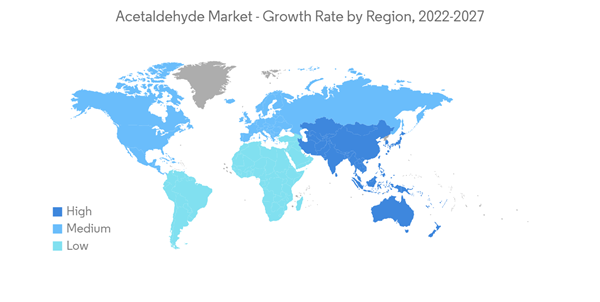The acetaldehyde market is expected to grow at a CAGR of over 6% during the forecast period.
The COVID-19 pandemic impacted the market negatively. However, the market has now been estimated to have reached pre-pandemic levels and is expected to grow steadily in the forecast period.
Asia-Pacific dominates the market and is expected to witness the fastest growth during the forecast period.
This product will be delivered within 2 business days.
The COVID-19 pandemic impacted the market negatively. However, the market has now been estimated to have reached pre-pandemic levels and is expected to grow steadily in the forecast period.
Key Highlights
- Over the short term, the major factors driving the market studied are the increasing demand in the food and beverage industry and the rising demand for pyridines in Asia-Pacific.
- On the flip side, the replacement of acetaldehyde with methanol in the production of acetic acid is the major hindrance to the acetaldehyde market.
Asia-Pacific dominates the market and is expected to witness the fastest growth during the forecast period.
Acetaldehyde Market Trends
Increasing Demand from Food and Beverage Sector
- Acetaldehyde is known as the aldehyde of acetic acid. It is also known as ethanal, acetic aldehyde, and ethyl aldehyde. It is primarily present at low levels in some foods made through fermentation, such as milk products, soy products, canned vegetables, and non-alcoholic beverages.
- Additionally, it is also found in fruit and fruit juices. It is also used as a food flavoring agent that is further added to some pastries, fruit juices, desserts, and milk products.
- According to the United States Census Bureau, in February 2022, retail and food services sales in the United States were USD 658.1 billion, up 0.3% from the previous month and 17.6% higher than in February 2021.
- According to FoodDrinkEurope, the European Union's food and drink industry production increased by 0.6% in Q2 2022, compared to the previous quarter. In Q2 2022, the food and drink industry production index accounted for 109.5, compared to 108.9 in Q1 2022 and 106.1 in Q2 2021.
- Also, between December 2021 and January 2022, the amount of food, drinks, and tobacco made each month in the United Kingdom went up by 2.8%.
- During the forecast period, these growth factors will likely drive the market for the food and beverage industry, which in turn will drive the market for acetaldehyde.
Asia-Pacific to Dominate the Market
- Asia-Pacific was the largest market for acetaldehyde, primarily due to the robust demand from China.
- Increasing demand from the food and beverage industries for paints and coatings combined with adhesives segments is expected to drive the Asia-Pacific market studied.
- The demand for acetaldehyde is expected to grow in the food processing industry in China. China's national food industry made a total profit of CNY 618.71 billion (USD 95.88 billion) from January to December 2021, increasing by 5.5% year on year. Among them, the wine, beverage, and refined tea production businesses had a total profit of CNY 264.37 billion (USD 40.97 billion), a rise of 24.1 percent over the previous year.
- China is known for its industrialization and manufacturing sector, where paints and coatings are widely required. Some of the major sectors where paints and coatings are used in the country are automotive, industrial, and construction, among others.
- China accounts for more than one-fourth of the global coatings market. According to the China National Coatings Industry Association, the industry has been registering a growth rate of 7% through recent years.
- With the rapid growth of food start-ups, industrial giants are increasingly investing in promoting innovation across the food supply chain. For instance, Jubilant Foodworks Ltd., the operator of Domino’s Pizza and Dunkin’ Donuts, has started test runs of a Chinese fast-food venture, promising opportunities in the country. This growth in China's food and beverage sector is expected to create new avenues for acetaldehyde demand.
- According to Invest India, India’s food processing sector is one of the largest in the world, and its output is likely to reach USD 535 billion by 2025 or 2026. Through the Ministry of Food Processing Industries (MoFPI), the government of India is engaged in various activities to boost investments in the food processing industry in the country.
- Some of the key players operating in the paints and coatings business in India are Asian Paints, Berger Paints, Kansai Nerolac, and Akzo Nobel India. Recently, various companies have announced their capacity expansions, which is likely to boost the demand for paints and coatings formulations in the country.
- Such factors, in turn, are likely to create promising opportunities for acetaldehyde in the country and thus in the region.
Acetaldehyde Market Competitor Analysis
The acetaldehyde market is consolidated in nature. Some of the prominent players in the market include (not in any particular manner) Celanese Corporation, Eastman Chemical Company, Sumitomo Chemical Co., Ltd., LCY GROUP, and Merck KGaA, among others.Additional benefits of purchasing the report:
- The market estimate (ME) sheet in Excel format
- 3 months of analyst support
This product will be delivered within 2 business days.
Table of Contents
1 INTRODUCTION
4 MARKET DYNAMICS
5 MARKET SEGMENTATION (Market Size in Value)
6 COMPETITIVE LANDSCAPE
Companies Mentioned (Partial List)
A selection of companies mentioned in this report includes, but is not limited to:
- Ashok Alco - chem Limited (AACL)
- Celanese Corporation
- Eastman Chemical Company
- Jubilant Ingrevia Limited
- Laxmi Organic Industries Ltd.
- LCY GROUP
- Lonza
- Merck KGaA
- Sekab
- Sumitomo Chemical Co., Ltd.
Methodology

LOADING...










